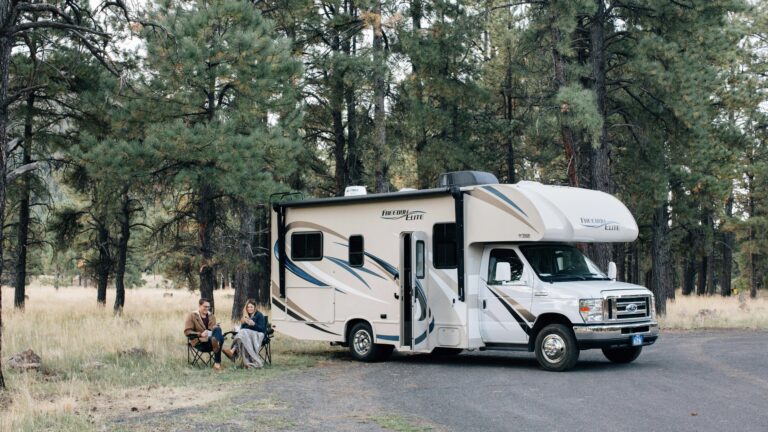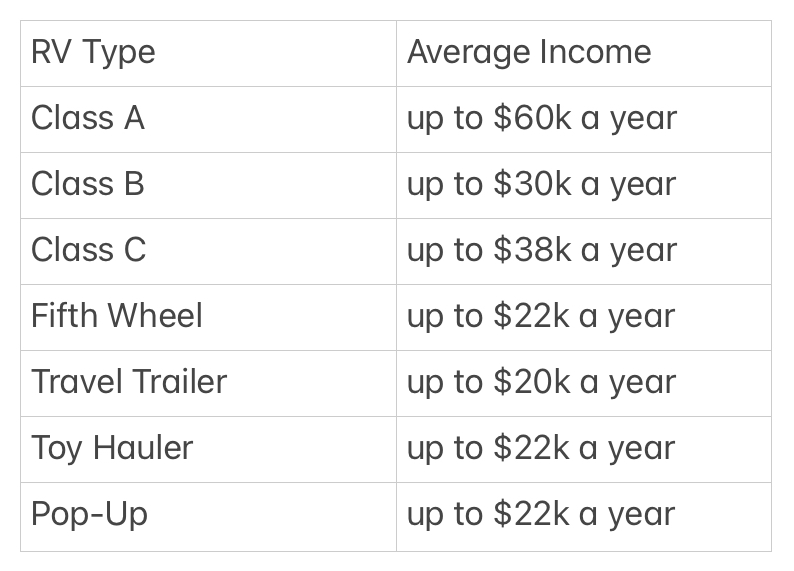
Is your RV sitting unused in your driveway for most of the year? Renting your RV when you’re not taking a trip is a great way to fund your adventures or make some money on the side. If you’ve been wondering if renting out your RV is a good idea, the answer is yes! And it’s super easy to get started renting your RV and earning rental RV income.
How Much Money Can I Make Listing My RV?
How much can you make renting an RV out? Your rental RV income will depend on a few factors such as the type of rig, how new it is, where you’re located, and how often you rent it out.
Some RVshare owners can make anywhere from $10,000 up to $40,000+ a year in extra income by renting out their RVs when they’re not being used. One owner, Denton, made close to $68,000 dollars in a single year renting out his RV through RVshare. Another owner, Dianna, started getting inquiries immediately on her newly listed camper and has already made about $10,000.
To give you a better idea, here’s a breakdown of the average amount you could make based on the type of RV you’re renting:

Why List Your RV for Rent?
When you first bought your RV, you were positive it was a great decision, but now, you might be second-guessing that. The trips you’ve taken in your RV are some of the best times you’ve ever had, but every month, you’re reminded of just how much that RV costs.
Some of the costs associated with owning an RV include:
- RV payments
- Repairs and maintenance
- Insurance
- Storage costs
You don’t want to sell your RV, but you also don’t want the cost of owning it to spoil the fun times you’ve had on your trips. This is where renting your RV can come into play. You can rent out your RV and make rental RV income to offset the costs of ownership and possibly even bring in some extra income like in the examples above.
How to Make Rental RV Income Listing Your RV through RVshare
Making money by renting out your RV through RVshare is simple.
- Start by creating a listing on RVshare.com. You’ll need to set the dates your RV is available to be rentedand decide on your rates and any fees. Additionally, you will need to upload some photos of your rig.
- You’ll also want to add a detailed description of your RV. This will allow interested renters to learn anything they might need to know about your camper.
- Once your RV is listed, you’ll be able to review any inquiries about your listing and work with the renters to negotiate terms and prices.
- After you’ve agreed to terms with a renter you’ll set up a date that works for both of you. Then the renter will come to pick up the RV (unless you offer to deliver it). You’ll give them a short tutorial, and they’ll be on their way!
- RVshare will securely handle your payment and release the funds to your bank account the day after the start of the rental.
- At the end of their trip, the renter will return your RV. At that point you’ll be all set to either rent it out again or go on a trip of your own!
Why Choose RVshare to Make Rental RV Income?
There are many ways to list your RV and start making rental RV income, so why choose us? Lots of reasons!
- RVshare has the largest peer-to-peer RV rental marketplace that reaches millions of RV renters every year.
- RVshare provides one-on-one training and rental coaches. They will teach you everything that you need to know to start renting your RV and make money.
- You’ll also have access to all necessary documents such as reservation forms, rental contracts, accounting forms, and insurance information.
- With RVshare you have total control over how you price your RV, who you rent to, and both you and your renters are covered with liability, collision, and comprehensive insurance, as well as 24/7 roadside assistance.
- You also have control over whether smoking and pets are allowed in your RV and where the RV can be taken.
- RVshare securely handles all payments and deposits the funds directly to your bank account.
- RVshare is free to join. You’ll pay a small commission fee only when your rig is booked.
Setting Your Rental Rates
To decide what to charge for your rental RV, you’ll have to consider several different factors. These include the type, age, make, and model of your rig and your location. We recommend looking at similar rental RVs in your area and using the rates being charged for those rigs to determine what your RV might rent for. You can also change your rates based on the season or whether a special event is happening. During peak season in your area, raise your rates a bit. Your rental RV income will almost certainly go up as well.
How Does a Renter Find Your Listing?
It’s just as easy for renters to find your listing as it was for you to post it. All a potential renter has to do is enter the area they want to pick up the RV rental, their trip dates, and the type of RV they’re interested in.
We’ll provide them with all the listings that match their search. If they’re interested in your listing, all they’ve got to do is request to book!
Ready to make some money by renting out your RV? Get started today!






